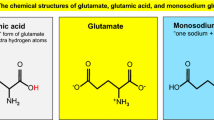Abstract
Recent results suggest that cytokine and glutamate receptors can interact directly and form receptor heteromers. Due to such heteromers, cytokines can act not only as classical neuromediators but also directly enhance glutamate gated ion channel activity via allosteric mechanisms. Our opinion is that such heteromers may lead to enhanced glutamate neurotoxicity in pathogenic processes of multiple sclerosis. Thus, agents targeting evolutionary conserved leucine-rich motifs responsible for such dimerization of receptors may represent a useful strategy to inhibit excitotoxicity in multiple sclerosis.




Similar content being viewed by others
References
AGGRESCAN (2008) Prediction of “hot spots” of aggregation in polypeptides. http://bioinf.uab.es/aggrescan/
Agnati LF, Fuxe KG, Goncharova LB, Tarakanov AO (2008) Receptor mosaics of neural and immune communication: possible implications for basal ganglia functions. Brain Res Rev 58:400–414
Aguirre JA et al (2008) The novel cyclooxygenase-2 inhibitor GW637185X protects against MPTP-toxicity. NeuroReport 19:657–660
Bell JK et al (2005) The molecular structure of the Toll-like receptor 3 ligand-binding domain. Proc Natl Acad Sci USA 102:10976–10980
Block ML, Zecca L, Hong J-S (2007) Microglia-mediated neurotoxicity: uncovering the molecular mechanisms. Nat Rev Neurosci 8:57–59
Boggild M (2006) Rationale and experience with combination therapies in multiple sclerosis. J Neurol 253(Suppl 6):vi45–vi51
Conchillo-Sole O et al (2007) AGGRESCAN: a server for the prediction and evaluation of “hot spots” of aggregation in polypeptides. BMC Bioinformatics 8:65
El-Asmar L et al (2005) Evidence for negative binding cooperativity within CCR5–CCR2b heterodimers. Mol Pharmacol 67:460–469
Fernandez-Busquets X et al (2008) Recent structural and computational insights into conformational diseases. Curr Med Chem 15:1336–1349
Fuxe K et al (2007) Intramembrane receptor–receptor interactions: a novel principle in molecular medicine. J Neural Trans 114:49–75
Fuxe KG, Tarakanov AO, Goncharova LB, Agnati LF (2008) A new road to neuroinflammation in Parkinson’s disease? Brain Res Rev 58:453–458
Gay NJ, Gangloff M, Weber ANR (2006) Toll-like receptors as molecular switches. Nat Rev Immunol 6:693–698
Goncharova LB, Tarakanov AO (2007) Molecular networks of brain and immunity. Brain Res Rev 55:155–166
Goncharova LB, Tarakanov AO (2008a) Nanotubes at neural and immune synapses. Curr Med Chem 15:210–218
Goncharova LB, Tarakanov AO (2008b) Why chemokines are cytokines while their receptors are not cytokine ones? Curr Med Chem 15:1297–1304
Guyon A, Nahon J-L (2007) Multiple actions of the chemokine stromal cell-derived factor-1α on neuronal activity. J Mol Endocrinol 38:365–376
Hirono M, Yoshioka T, Konishi S (2001) GABA(B) receptor activation enhances mGluR-mediated responses at cerebellar excitatory synapses. Nat Neurosci 4:1207–1216
Matsushima N et al (2007) Comparative sequence analysis of leucine-rich repeats (LRRs) within vertebrate toll-like receptors. BMC Genomics 8:124–145
Mellado M et al (2001) Chemokine receptor homo or heterodomerization activates distinct signaling pathways. EMBO J 20:2497–2507
Mizuno T et al (2008) Interferon-γ directly induces neurotoxicity through a neuron specific, calcium-permeable complex of IFN-γ receptor and AMPA GluR1 receptor. FASEB J 22:1797–1806
NCBI (2008) National center for biotechnology information. http://www.ncbi.nlm.nih.gov
O’Brien K, Fitzgerald DC, Naiken K, Alugupalli KR, Rostami AM, Gran B (2008) Role of the innate immune system in autoimmune inflammatory demyelation. Curr Med Chem 15:1105–1115
PDB (2008) Protein data bank. http://www.rcsb.org/pdb
Percherancier Y et al (2005) Bioluminescence resonance energy transfer reveals ligand-induced conformational changes in CXCR4 homo and heterodimers. J Biol Chem 280:9895–9903
Pickering M, Cumiskey D, O’Connor JJ (2005) Actions of TNF-α on glutamatergic synaptic transmission in the central nervous system. Exp Physiol 90:663–670
Qiu Z, Sweeney DD, Netzeband JG, Gruol DL (1998) Chronic interleukin-6 alters NMDA receptor-mediated membrane responses and enhances neurotoxicity in developing CNS neurons. J Neurosci 18:10445–10456
Radons J et al (2003) The interleukin 1 (IL-1) receptor accessory protein Toll/IL-1 receptor domain. J Biol Chem 278:49145–49153
Rodriguez-Frade JM, Mellado M, Martinez AC (2001) Chemokine receptor dimerization: two are better than one. Trends Immunol 22:612–617
Springael JY et al (2006) Allosteric modulation of binding properties between units of chemokine receptor homo- and hetero-oligomers. Mol Pharmacol 69:1652–1661
Takahashi Y (2008) Epitope of autoantibodies to N-methyl-d-asparate receptor heteromers in paraneoplastic limbic encephalitis. Ann Neurol 64:110–111
Takahashi Y et al (2003) Autoantibodies to NMDA receptor in patients with chronic forms of epilepsia partialis continua. Neurol 61:891–896
Takeuchi H et al (2006) Tumor necrosis factor-α induces neurotoxicity via glutamate release from hemichannels of activated microglia in an autocrine manner. J Biol Chem 281:21362–21368
Uings IJ, Farrow SN (2000) Cell receptors and cell signalling. J Clin Pathol Mol Pathol 53:295–299
Vila-Coro AJ et al (1999) The chemokine SDF-1alpha triggers CXCR4 receptor dimerization and activates the JAK/STAT pathway. FASEB J 13:1699–1710
Viviani B et al (2003) Interleukin-1beta enhances NMDA receptor-mediated intracellular calcium increase through activation of the Src family of kinases. J Neurosci 23:8692–8700
Watovich SS et al (1996) Cytokine receptor signal transduction and the control of hematopoietic cell development. Annu Rev Cell Dev Biol 12:91–128
Xu Y et al (2000) Structural basis for signal transduction by the Toll/interleukin-1 receptor domains. Nature 408:111–115
Author information
Authors and Affiliations
Corresponding author
Rights and permissions
About this article
Cite this article
Tarakanov, A.O., Fuxe, K.G., Agnati, L.F. et al. Possible role of receptor heteromers in multiple sclerosis. J Neural Transm 116, 989–994 (2009). https://doi.org/10.1007/s00702-009-0197-x
Received:
Accepted:
Published:
Issue Date:
DOI: https://doi.org/10.1007/s00702-009-0197-x




